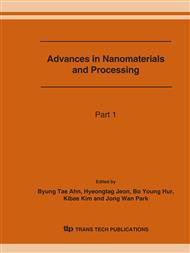p.45
p.49
p.53
p.57
p.61
p.65
p.69
p.73
p.77
Initial Growth Mode of GaN Film on Stepped Sapphire
Abstract:
The initial GaN growth mode on stepped sapphires by plasma enhanced metal organic molecular beam epitaxy (PEMOMBE) has been analyzed using in-situ, real time synchrotron x-ray diffraction and x-ray absorption. The sapphire substrate annealed at high temperature had flat terraces and regular atomic steps. The crystal quality and the vicinal angle of sapphire substrate had an effect on the width of terraces and the step arrangement. The initial growth mode of the GaN film on the regular atomic step (AS) surface was the layer-by-layer mode and changed to the 3D growth mode within 2 bilayer thickness. In the meanwhile, the growth mode of the GaN film grown on the sapphire with random roughness (RR) surface made the flat surface in the early stage and changed the 3D growth mode. As increasing the film thickness, the nucleation layer grows strain-free hexagonal GaN on stepped sapphires
Info:
Periodical:
Pages:
61-64
Citation:
Online since:
June 2007
Authors:
Keywords:
Price:
Сopyright:
© 2007 Trans Tech Publications Ltd. All Rights Reserved
Share:
Citation:


